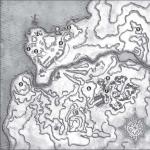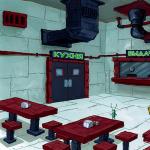Technological equipment and production inventory used in the preparation of fish. Rules for the safe operation of equipment and inventory. Classification and main types of commercial equipment on the example of LLC "Golden Troika"
Commercial equipment is divided into the following types: commercial non-mechanical equipment (commercial furniture), measuring equipment, cash register equipment, refrigeration equipment, handling equipment, packing and packing equipment.
Commercial equipment is various types both in content and purpose. So, all commercial equipment can be divided into two main types:
1. Special - this is everything that is used in any particular area of \u200b\u200btrade, and at the same time may be completely unsuitable for another. The special category includes, for example, refrigeration equipment required exclusively for the food sector;
2. Universal. to generic type commercial equipment counters, racks, showcases used to accommodate a wide range of goods.
AT last years the main trend in the development of trade has become the universalization of stores, there are more and more hypermarkets, where you can find almost all the products of the market in one great hall. Here there is a need for simultaneous storage and sale of goods, and in the most compact and at the same time accessible form, using the entire possible volume of the premises. Related to this is the ever-increasing demand for universal trade equipment - equipment that is equally convenient for displaying any type of product.
For systematization technological process, starting from delivery, acceptance, cutting, packaging, packaging, storage, and ending with settlements with customers, commercial equipment is classified according to a number of generalizing features:
By functional purpose (weight measuring, refrigeration and other equipment);
By the nature of the impact on the processed product (in refrigeration equipment for storing chilled or frozen products);
According to the structure of the working cycle (machines for periodic or continuous action);
By the degree of automation (machines of non-automatic or automatic action);
By type of energy used (manual drive, electric, etc.);
According to the degree of versatility (specialized equipment for performing one operation of the technological process or universal for performing several
To perform various operations related to the acceptance, storage, preparation for sale, display and sale of goods, non-mechanical trade and technological equipment (furniture for retail premises) is used in stores. One of the main functions of commercial non-mechanical equipment is to ensure the technological process at a commercial enterprise.
Being the main type of equipment of this enterprise, it is slides, hangers, container-equipment, counters, showcases, racks and other products necessary for performing basic trading operations. The right set of furniture allows you to:
Rationally organize the trade and technological process;
Mechanize heavy and labor-intensive operations;
Expand the range of products;
Maximize the use of the area and volume of retail and warehouse premises;
Reduce product losses;
Introduce progressive forms of sale;
Increase the level of trade services, the productivity of trade workers, work efficiency trade enterprises;
Improve the aesthetic design of commercial premises.
Furniture used in commercial enterprises is divided according to the following criteria:
1) functional purpose:
For displaying goods (showcases, stands),
For display and sale of goods (slides, hangers, counters),
For display, transportation, temporary storage and sale of goods (container-equipment),
For settlements with customers (cash desks),
For storage of goods (shelving, pedestals),
To check the quality and prepare goods for sale (tables for grading goods, packing goods),
To provide additional services to customers (fitting booths, tables for packing goods, counters for sorting baskets and bags of customers, bedside tables for control weights), etc.;
2) place of use - in the trading floors of shops, in premises for receiving, storing and preparing goods for sale, in utility rooms;
3) installation method - wall-mounted (installed along the perimeter of the trading floor), island (installed in the center of the trading floor), hinged and built-in;
4) product profile - specialized and universal; specialized furniture is adapted for a certain group or type of goods (slides for fabrics, bakery products), universal furniture is suitable for different groups goods;
5) material of manufacture - metal, wood, combined, using metal, wood, glass, plastics and other materials. Metal parts of furniture are made from round pipes and rectangular sections, bar, wire, angle steel, sheet steel, aluminum. To finish their surfaces, zinc, enamel and other coatings are used. On the wooden details consume lumber, chipboard and fiberboard, plywood;
6) structures - non-separable, collapsible, folding, collapsible-folding, sectional, universal-team. Non-separable furniture consists of parts interconnected by permanent connections. Details of collapsible furniture are connected using bolts, screws, brackets, hooks and other detachable connections. Folding and collapsible furniture has parts with articulated joints that allow them to be folded, thereby reducing the size of the furniture and the volume it occupies. Sectional furniture consists of separate sections. The section is a finished product, equipped with the necessary details: shelves, drawers, brackets, etc. Sections are installed separately or connected to other sections. In this case, blocks or lines of any length are formed. When connecting sections in a line, fewer support posts are required, which reduces the weight of furniture, the cost of its purchase and installation. Universal-prefabricated furniture consists of unified legal units, from which you can assemble furniture of various functional purposes and sizes. Using a combination of various details, as well as a combination of various devices for displaying goods, you can create a wide variety of types of furniture for organizing trade in all groups of food and non-food products;
7) completeness - piece goods and sets of furniture. Commercial equipment factories produce both individual products by orders of trade organizations and furniture sets. Sets are a group of products with different functional purposes with the same architectural and artistic design;
8) the nature of production - experimental, serial and mass. Experimental furniture is made in in large numbers to identify the advantages, disadvantages and needs of commercial enterprises in it. Serial - produced in more or less large batches (series) according to the results of manufacturing and testing of experimental samples. Mass furniture is produced in large quantities for a long time without changing the design.
For furniture for trade enterprises are presented:
operational, economic, ergonomic, aesthetic, sanitary and hygienic requirements.
1. Operational requirements. The most important operational requirements are:
Convenience for visual display, demonstration and selection of goods by customers;
Sufficient capacity;
Possibility of prompt replenishment of stocks of goods;
Compliance of the design with the requirements for optimal use of the area of the trading floor;
Standard sizes and collapsible design;
Ensuring the safety of goods and the possibility of using the most rational methods of their layout and placement;
Sufficient strength.
Furniture should be comfortable for both customers and store employees.
2. Economic requirements. The design of furniture for a trade enterprise should be simple, economical in production and operation. Profitability of production is determined by the complexity of the application progressive technology production, and the efficiency of operation - the degree of convenience for customers and store employees, reliability, functional expediency. Furniture should not take up much space, but at the same time it should be capacious enough to provide layout and storage. required amount goods;
3. Ergonomic requirements. The optimal dimensional ratios of furniture for trade enterprises (length, width, height, distance between shelves, etc.) are determined during its design, taking into account anthropological data - average height and proportions of a human figure. This provides free access to goods, good visibility for customers and minimal fatigue. service personnel when filling furniture with goods.
4. Aesthetic requirements. The shape, proportion and color of the furniture should correspond to its functional purpose and the architectural and artistic design of the interior of the trading floor, emphasizing the unity of the ensemble of the interior of the store, the arrangement of commercial furniture should not play an independent role.
5. Sanitary and hygienic requirements. The design of the furniture of trade enterprises should not make it difficult to clean the premises and the furniture itself. For finishing furniture, materials should be used from which dirt can be easily removed. The surface of the furniture should be smooth, without protrusions, sharp corners, gaps and cracks. To protect goods from dust and pollution, visors, canopies, covers should be arranged.
19.01.17
Cook, confectioner
(code, name of profession)
Admitted to the defense
Deputy Director of MMR
________ N.V. Osipenko
WRITTEN EXAM WORK
Topic: The technological process of preparing a complex lunch:
- Shchi with fresh cabbage. - Stuffed peppers. - Kissel. . - Baby bun.
Student(s): Semenova O.V.
Group No. 131 PCS
Work is done _______
Student(s) signature_____
Head of work _______ L.N. Krasovskikh "___" _______ 2016
Introduction 3
Explanatory note 4-9
Conclusion 10
Literature 11
Annex 12
Introduction Cooking a complex lunch is a hot topic. AT modern age speed is the main task of enterprises Catering feed the population quickly, tasty and as useful as possible. For any category of the working population, it is possible to develop a lunch ration taking into account the required calorie content of dishes.
The purpose of writing examination work"The technological process of preparing a complex lunch: ... .." is a description technological operations preparation and decoration of dishes and confectionery using modern equipment in accordance with the requirements qualification characteristic by profession OK "Cook" 4 categories, OK "Confectioner" 3 categories.
To achieve this goal, it is necessary to describe the sequence of stages of this work: 1. selection of products in accordance with the recipe and requirements for their quality; the sequence of cooking and confectionery; quality requirements ready meals and products, storage conditions and terms of sale of dishes and confectionery. 2. sanitary and hygienic requirements for the preparation of the workplace in the culinary and confectionery shops, the conduct of the technological process of cooking; 3. organization of the workplace in the shops; 4. types of equipment, inventory, tools, utensils used; 5. safety regulations for the performance of work.
Explanatory note Shchi from fresh cabbage
Cooking.Vegetables must be fresh, elastic in texture, with a color, taste and smell characteristic of the species, without strangers. Vegetables are well cleaned and washed. Cabbage is cut into checkers or strips, potatoes - into cubes or sticks, onions - into half rings, carrots - into strips. Onion, carrot, tomato -
pass in fat. Cabbage is put into boiling broth or water, brought to a boil, potatoes are put, brought to a boil, passivation, salt, Bay leaf. Boil until cooked at a low boil. Ready cabbage soup is left to stand without boiling for 5-10 minutes to form the taste and smell. Meat is placed in a deep soup bowl, cabbage soup of medium density is poured, sour cream is added and finely chopped parsley or dill is sprinkled. Serving temperature + 65-70C.
quality requirements: The consistency of the soup is medium thick. There are glitters of orange fat on the surface. The broth is transparent. The taste is slightly sweet, with the aroma of sautéed vegetables, moderately salty, without the smell of steamed cabbage. Vegetables should keep their cut shape.
Stuffed Peppers(Collection of recipes 2010, page)
Cooking. Wash the vegetables, remove the stem. Carrot, onion cut into strips, sauté with tomato. Then combined with boiled rice, salt, pepper, parsley and mixed. Prepared peppers are filled with minced meat, placed on a baking sheet or a portioned frying pan, poured with medium-thick sour cream and tomato sauce and baked in an oven until cooked at a temperature of 200-220C for 15-20 minutes. Served at a temperature of 65-70C. Store in the oven for no more than 2 hours.
Quality requirements: The dish is covered with a golden crust, the texture is soft, juicy. Taste is mildly salty.
Kissel from fresh berries:(Collection of recipes 2010, page)
Cooking. The berries should be fresh, not crushed, without rot. The berries are sorted, washed, kneaded with a pestle, squeezed out the juice and stored in the refrigerator. The squeezed pulp is poured with water and boiled for 5-10 minutes. Filter. Starch is combined with water and stirred. The broth is combined with sugar, brought to a boil and poured in a solution of starch, juice from the refrigerator. Stir quickly and turn off the heat and sprinkle the surface with sugar so that a film does not form. Kissel is cooled and served in glasses at a temperature of +10-14C.
Quality requirements: The color of jelly is saturated translucent, the taste and smell are pleasant, characteristic of used berries. Consistency is uniform. Film on the surface is not allowed. baby bun (Collection flour solution confectionery 2010) Quality requirements: products must be correct form, evenly sprinkled with sugar, golden color, well baked, porous, soft, with a pleasant taste and smell, without strangers.
Dough kneading: The quality of products is evaluated by an organoleptic method according to appearance, color, smell, which must meet the requirements of GOST. Flour, sugar, salt - sifted using a Pioneer type sifter or a hand sieve to remove impurities. Margarine is freed from packaging, cleaned, softened. Melange is defrosted in warm water and use up to 4 hours. Yeast is dissolved in warm water up to 40C and filtered. In the bowl of the dough mixing machine, the dough is kneaded from a solution of yeast, flour and milk. The dough is kneaded for 10 minutes and left to ferment for 2-3 hours. During fermentation, 1-2 punches are made. Finished dough - fluffy, porous, with an alcoholic smell and a sour taste. Forming and baking. The dough is cut on the table by 88 grams, rounded into a ball and placed on a confectionery sheet.
Molded products are melted for 30-40 minutes on racks until doubled in size and baked in baking ovens at a temperature of 200-220C for 10-15 minutes until golden brown and with a pleasant aroma. Finished goods cool.
Quality requirements: products should be of the correct shape, evenly golden in color, well baked, porous, soft, with a pleasant taste and smell, without foreigners Yield: 80 grams. Terms and conditions of storage: store products on clean wooden trays, laid in rows on their sides at a temperature of 18-20C, air humidity 65-70% for 12 hours.
2.Sanitary and hygienic requirements:
Salads are prepared in a cold shop, where strict sanitary regulations, cleanliness of the room, labeling of inventory and utensils, since most cold dishes are not subjected to heat treatment after cooking. All work surfaces, inventory, tools, hands of the cook are well washed with approved detergents and disinfected with disinfectants. Store finished products in refrigerators at temperatures from +4 to +8C and sell them strictly deadlines- salads 1 hour. Salads are served in salad bowls or snack plates. In the hot shop, they also observe the cleanliness of the premises and work tables, the labeling of inventory, the observance of the neighborhood of products, semi-finished products and ready meals. Hot dishes are stored on a food warmer at a temperature of + 70-75C for 2-3 hours. Hot dishes are served in clean heated plates at a temperature of + 65-75C.
3.Organization of the workplace. The area of the working area is not less than 6 square meters per cook. The workshop must have heating, lighting, ventilation, hot and cold water supply. The workshop uses production tables for manual operations with built-in wardrobes. The chef must have everything necessary types equipment, inventory, tools and utensils. Cold dishes are prepared in a cold shop, first and second courses, drinks in a hot shop, flour products in confectionery shop
Types of equipment, inventory, tools, utensils for cooking and dispensing dishes.
In the technological process of preparing a complex lunch, the following equipment was used: scales for weighing products; washing baths for washing products; a vegetable cutter for cutting vegetables, a refrigerator for storing semi-finished products, an electric or gas stove for cooking cabbage soup, cooking jelly, an oven for roasting peppers; food warmer for storing ready-made hot dishes. Inventory was also used: knives and cutting boards marked OS, MS, KC. For serving dishes, a 500-gram soup plate, a flat plate for the second dish or a portioned frying pan, a glass for jelly, a patty plate for a bun were used.
5. Safety precautions when performing work: All electrical equipment must be grounded. There should be rubber mats in front of switches and machines. The safety of the machine depends on the design of the presence of fences, blocking devices. Before turning on the equipment, make sure that there are no foreign objects in the working chamber and near the moving parts. The correct assembly and serviceability of the vegetable cutting machine should be checked at idle. Do not overload the working chambers of machines with products, leave the switched on equipment unattended. Do not overheat the burners and oven to avoid damage. When working with hot containers, use oven mitts, lift hot containers only with two people. Do not overload the mixing bowl with dough. When installing the bowl, the locking mechanism must be securely fastened so that the bowl does not move when kneading the dough. After finishing work, turn off all equipment, cool it down and sanitize it.
Conclusion
To perform the written examination work, the theoretical material on the proposed literature was studied, the skills of cooking and confectionery were worked out during the training and industrial practice to perform practical qualifying work on the topic "The technological process of preparing a complex lunch: ... .. ". The set goals and objectives were met in full.
The paper gives a description of the technological processes of preparation culinary specialties and confectionery products using modern equipment; description of sanitary and hygienic requirements, organization of the workplace and safety precautions at the workplace.
A description was made of all stages of the preparation of culinary dishes and confectionery, quality requirements finished products, rules for storage and distribution of dishes and products.
The explanatory note is based on theoretical material, normative - technical documentation, SanPiNa.
Used Books
1.Anfimova, N.A. Cooking: A textbook for the beginning. vocational education: Textbook for environments. Prof. Education / N.A.Anfimova L.L.Tatarskaya. -2nd ed.ster. - M .: Information Center "Academy", 2010.- 328s.
2. Buteykis N.G. Technology for the preparation of flour confectionery products: Textbook for the beginning of vocational education / N.G. Buteykis, A.A. Zhukova. - 3rd ed.
2. Zolin, V.P. Technological equipment catering establishments: A textbook for the beginning. prof. Education: Proc. allowance for Wednesdays. professional education / V.P. Zolin. -8th ed.ster.- M .: Information Center "Academy", 2010.- 320s.
3. Matyukhina, Z.P. commodity science food products: Textbook for the beginning. prof. Education: Proc. Manual for secondary vocational education / Z.P. Matyukhina, E.P. Korolkova. - 4th ed. Ster. - M .: Information Center "Academy", 2009. -272s.
4. Kharchenko, N.E. Collection of recipes for dishes and culinary products: studies. Allowance for the beginning. vocational education / N.E. Kharchenko.-3rd ed., Ster.-M.: Information Center "Academy", 2010-496s.
Public catering establishments must be equipped with equipment and items of material technical equipment in accordance with current regulations.
In accordance with sanitary requirements, the materials from which equipment, inventory, utensils, containers for catering establishments are made should not harmful effects on products and cause changes in their quality and properties. They must be resistant to acids and alkalis, easy to clean and disinfect, not rust, and have a smooth surface. Such requirements are met by stainless steel, aluminum, duralumin, cupronickel, nickel, some types of plastic, porcelain, faience, glass, etc.
Equipment requirements. Technological equipment of public catering enterprises can be mechanical, thermal, refrigeration and non-mechanical.
The shape and design of the equipment must comply with sanitary requirements to facilitate the work of workers and increase its productivity. Currently, these requirements are met by modular (certain overall dimensions) equipment, made in the form of separate sections that are easily assembled into different combination for hot, cold, confectionery shops.
The equipment is placed in industrial premises taking into account the sequence of the technological process, excluding counter and cross flows of movement of raw materials, p / f., prepared food. To ensure free access to the equipment, passages to it are provided with a width of at least 1.2-1.5 m.
The most modern is the linear arrangement of modular-sectional equipment, which creates a single production line improves the sanitary condition of the enterprise and the working conditions of the personnel. As a rule, these lines are placed along the walls or in the middle of the room, freeing production area for the normal movement of workers. Lines are built in above thermal devices exhaust ventilation, which improves the sanitary condition of the air environment of production.
mechanical equipment must have working parts of machines made of stainless steel, external parts painted with enamel paint. After work, the equipment is thoroughly cleaned, washed hot water, wipe clean towel and cover with a film or cloth cover. The working parts of the machines should be washed with the addition of various detergents, scalded, wiped, dried in heating cabinets separately in disassembled form.
Separate mechanical equipment must be used for grinding raw and cooked products, and in universal machines- interchangeable mechanisms.
Thermal equipment moreover, the most hygienic are electrical devices: stationary boilers, stoves and modular sectional mobile stoves, frying pans, deep fryers, ovens, which are assembled in line depending on the sequence of the technological process, confectionery cabinets in the confectionery industry. Everything thermal equipment kept clean. After work, thoroughly wash with hot water and detergents.
Refrigeration equipment in the form of cabinets, collapsible chambers, low-temperature counters and tables with refrigerated cabinets, freezers should be washed daily with hot water and ventilated.
Non-mechanical equipment include: production tables, production and washing baths, cutting chair, racks, stools, cabinets, etc.
Production tables must have a flat, smooth, durable, stainless surface. The most hygienic are all-metal tables made of stainless steel or duralumin, as well as tables with wooden lids for cutting dough in the kitchen and in pastry shops, which are made of hardwood (oak, birch, maple). Sanitary standards it is allowed to manufacture table covers from polymeric material-viniplast grades P-73 and P-74.
metal tables after each production operation they wash with hot water, and at the end of the working day they wash with detergent and rinse with hot water. Tables with wooden covers are cleaned with a knife and washed with hot water.
Cutting chair 80 cm high and 50 cm in diameter are made from a whole piece of hardwood (oak, beech, ash, maple) and mounted on legs 20 cm high. Side surface cutting stool after removing the bark is stained with light oil paint, leaving uncolored upper part 20cm wide. After work, it is recommended to clean the surface of the chair with a knife, sprinkle with salt and cover with a cover, and wash the side part with hot water. With wear and the appearance of deep nicks, the surface of the cutting chair is cut down.
Industrial baths are made of two-cavity stainless steel, duralumin or cast iron with an enamelled surface. The size of bathtubs should not exceed 1000x700x450mm. Baths are washed and maintained in the same way as production tables.
Production baths for washing eggs in the confectionery shop are made in four sections.
Washing tubs for tableware produced all-metal from three compartments with a volume of not more than 30 liters for faster and more frequent changes of water.
All baths are provided with hot and cold water and connected to the sewer network through an air gap, in order to avoid getting Wastewater in bathtubs with clogged sewers
Shelving, studs confectionery shops, stools made of duralumin, in the process they are washed with hot water.
Requirements for inventory and tools. The inventory includes: cutting boards, paddles, skimmers, screens, sieves, pastry bags, tips, special syringes, rolling pins, molds, recesses, combs, etc.
Cutting boards made from a whole piece of hardwood (oak, beech, birch, maple) with a smooth surface. It is allowed to manufacture boards from synthetic materials permitted by the State Sanitary and Epidemiological Supervision. All boards must be labeled in accordance with the product processed in them: MC-raw meat, MW-boiled meat, OS-raw vegetables, OB-boiled vegetables, RS-raw fish, RV-boiled fish, MG-meat gastronomy, RG- fish gastronomy, "Herring", X - bread, OK - pickled vegetables, etc. In the course of work, follow correct use boards according to the marking. After each operation, the boards are washed with hot water with detergents and a brush, having previously cleaned them with a knife from product residues, scalded with boiling water and stored on edge on a rack in special cassettes in the appropriate workshop.
Whole inventory. Wash with hot water and detergent. Wooden inventory is disinfected by rinsing with hot water at least 65 ° C. The inventory used to prepare the egg mass is thoroughly washed with a 0.5% solution of soda ash, then disinfected with 2% bleach and rinsed with hot water.
Sieves, gauze for straining the broth, pastry bags, tips after use are thoroughly washed in hot water with the addition of detergents. Then they are rinsed and boiled for 30 minutes and dried. For boiling and storage pastry bags and tips, use a special clean labeled container.
Brushes, washcloths, for washing equipment and dishes must be washed daily with detergents and stored in a specially designated place.
Tools(knives, choppers, chef's needles) are kept clean during work. Chef's knives, like cutting boards, must be assigned to the workplace and marked accordingly. Chef's knives, especially those made of rusting steel, should be kept dry.
All metal tools after washing with hot water are disinfected by boiling in water or pierced in an oven.
During non-working hours, clean inventory is stored in special cabinets or on closed racks.
Violation of the sanitary and hygienic rules for washing and maintaining inventory and tools can cause contamination of food products with microbes, and, consequently, the occurrence food poisoning and intestinal infections.
Requirements for kitchen utensils and containers. Kitchen utensils (pots, stove-top boilers no more than 60 liters, saucepans, teapots) are made of stainless steel, aluminum, duralumin with a smooth surface. In order to avoid the transfer of odors to dishes, all boilers are assigned to certain workshops and labeled depending on the dishes being prepared. Trays are made of untinned iron, and pans are made of cast iron. New forms, trays, sheets should be laid in ovens. It is forbidden to use molds, baking sheets and sheets with soot for baking.
for washing kitchen utensils use baths from two compartments. First, the dishes are freed from food debris with a brush or wooden spatula. Then they wash in the first compartment of the bath with washcloths and brushes with a detergent allowed at a catering establishment at a water temperature of 45-50 ° C, in the second they rinse with hot water at least 65 ° C. Dry and store the kitchen utensils upside down on a rack at a height not less than 0.5-0.7m from the floor. Before use, it must be rinsed with hot water, after checking the frequency inner surface utensils. The dishes with the remnants of burnt food are pre-soaked. It is recommended to wash baking sheets and pans after two or three single hot foods on them.
Kitchen utensils are not disinfected, as they are constantly subjected to heat treatment.
In catering establishments it is forbidden to use enamelware, as it is fragile, especially dishes with damaged enamel. Aluminum and duralumin cookware can only be used for food storage.
Container for p / f. made of aluminum, wood and polypropylene, which has the advantage. The containers are washed in special washing rooms or in washing kitchen utensils in specially allocated two-cavity baths using detergents and disinfectants.
Tableware requirements. Public catering establishments use porcelain, faience, glass and crystal dishes, as well as stainless steel, cupronickel; cutlery only from stainless steel and cupronickel. And recently, the use of plastic dishes has been allowed: for hot dishes - from melalite, for cold ones - from polystyrene.
special hygiene requirement presented for washing tableware. Most often washed in dishwasher. Less often by hand in a three-cell bath. Before washing, the dishes are cleaned of food debris with a wooden spatula and sorted by type.





